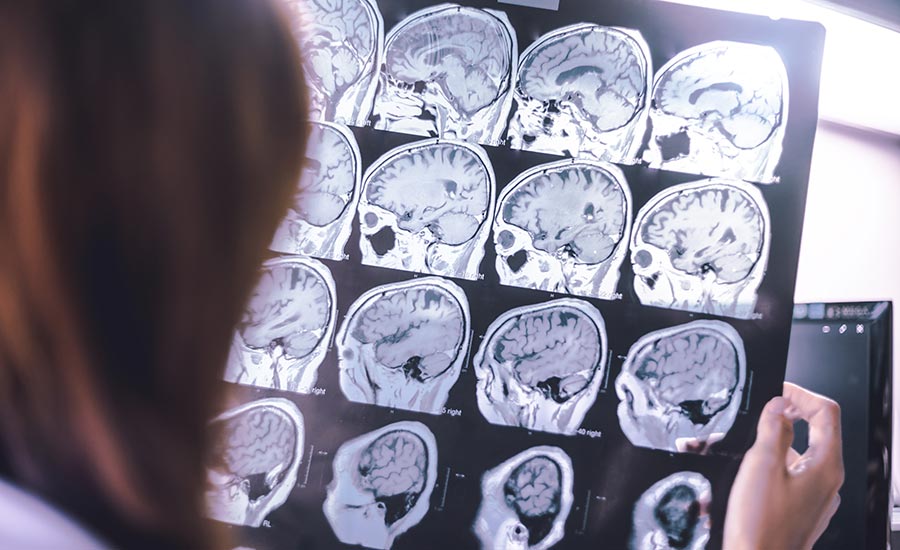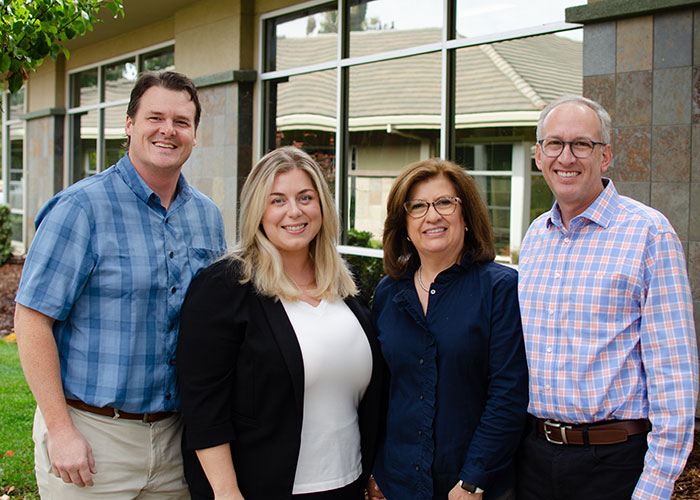What Is Frontotemporal Dementia? Types, Symptoms & Care

Frontotemporal dementia refers to a group of uncommon brain disorders that affect the regions of the brain that are responsible for personality, behavior, and language.
We’ll share everything you need to know about this condition, from the different types to symptoms and care management. Plus, we’ll explain how our experts at Always Best Care Senior Services can help if you’re caring for a loved one with dementia.
Table of Contents
What Is Frontotemporal Dementia?
Frontotemporal dementia (FTD), also called frontotemporal degeneration, refers to a group of brain conditions that affect the frontal and temporal lobes of the brain.
FTD results from progressive nerve cell loss or death in the brain’s frontal lobes — the area behind the forehead — or the temporal lobes — the area behind the ears.
Nerve cell loss or death can result from pathological causes, such as traumatic injury, cardiovascular conditions, or genetic diseases.
The frontal and temporal lobes play an important role in processing an individual’s language, behavior, decision-making, and emotion regulation.
What Causes Frontotemporal Dementia?
While the primary cause of FTD is unknown, scientists have found several factors that can lead to the condition, including:
1. Protein Abnormalities
Abnormal forms or an accumulation of proteins, such as tau gene or MAPT gene (linked to several neurodegenerative disorders) and TDP-43, have been observed in the brains of individuals with FTD.
Protein abnormalities can occur during the process of protein synthesis, folding, transport, or breakdown, leading to the disruption of nerve cell functioning and the loss of neuronal connections.
2. Changes in Genes
Some cases of FTD run in families, as several genetic mutations have been linked to the condition. The most common gene that is associated with FTD is the C9ORF72 gene.
While the exact mechanism by which C9ORF72 mutates remains unclear, research has shown that the expansion of the DNA repeat sequence in the gene — Hexanucleotide (GGGGCC) — can result in toxic protein production, leading to neuron damage and death.
3. Brain Atrophy
Brain imaging techniques, such as magnetic resonance imaging (MRI), often show atrophy or shrinkage of the frontal and/or temporal lobes in individuals with FTD.
This shrinkage can indicate the loss of nerve cells in these regions, leading to the characteristic behavioral and language symptoms observed in FTD.

Types of Frontotemporal Dementia
Frontotemporal dementia comes in different forms and results in a variety of symptoms, from subtle changes in behavior and language to severe cognitive impairments and motor dysfunction.
Types of FTD include:
1. Behavioral Variant Frontotemporal Dementia (bvFTD)
Behavioral variant frontotemporal dementia (bvFTD) is characterized by significant changes in personality, behavior, and social conduct.
These changes often manifest in apathy, impulsiveness, neglect of personal hygiene, or inappropriate social interactions — for example, making rude remarks.
Language and cognitive issues can also occur due to bvFTD, such as speaking in shorter phrases or losing the ability to speak.
2. Primary Progressive Aphasia (PPA)
Primary progressive aphasia (PPA) is characterized by a gradual decline in language abilities, including speaking, understanding, reading, and writing.
PPA is grouped into three sub-types:
- Semantic PPA: An individual gradually struggles to understand words and might not recognize familiar faces or objects.
- Agrammatic PPA: An individual finds speaking difficult, often skipping propositions, such as “to” or “from.” Over time, they stop speaking. They may also show movement issues resembling corticobasal syndrome, such as muscle stiffness or tremors.
- Logopenic PPA: An individual has difficulty finding the right words when talking, but can understand words, sentences, and grammar.
3. Movement Disorders
Movement disorders are characterized by abnormalities in body movements, such as tremors, stiffness, rigidity, poor muscle coordination, or involuntary movements.
Some movement disorders linked to FTD manifest as rare neurological conditions, including:
- Corticobasal syndrome: A condition caused by corticobasal degeneration, in which parts of the brain shrink and lose nerve cells over time. This can lead to increasing difficulties with movement, usually starting around age 60.
- Progressive supranuclear palsy: A rare neurological condition that affects balance, eye movements, and mobility. This condition is characterized by frequent falls, body stiffness, and loss of ability to make facial expressions.
Frontotemporal Dementia Symptoms
Frontotemporal dementia manifests in a wide range of symptoms, which can be grouped based on the primary domains they affect behavior, language, and motor functions.
While this condition can differ widely among individuals, some of the most common symptoms include:
- Behavior changes, such as apathy and agitation
- Distractibility
- Impaired judgment
- Compulsive behavior, such as repeating certain actions or rituals, like hand washing
- Anhedonia or the loss of interest in daily activities that were once enjoyed
- Emotional withdrawal from people
- Increased dependence on caretakers
- Decreased self-awareness
- Difficulty planning and organizing
- Difficulty recognizing familiar places or people
- Hesitation when speaking
- Aphasia or difficulty speaking, understanding speech, reading, and writing
How Is Frontotemporal Dementia Diagnosed?
Diagnosing frontotemporal dementia requires a comprehensive evaluation of clinical assessments, a detailed medical history, neuropsychological testing, brain imaging, and genetic evaluations.
To determine if an individual has FTD, a healthcare provider:
- Evaluates the medical history of the individual: The individual’s medical history provides crucial insights into the onset and progression of symptoms, previous illnesses, medications, and any familial history of neurodegenerative diseases.
- Conducts a thorough neurological examination: This assessment checks the individual’s reflexes, motor functions, balance, sensory responses, and other neurological aspects.
- Performs neuropsychological tests: These tests evaluate cognitive functions like memory, attention, language skills, and problem-solving capabilities, allowing the healthcare provider to pinpoint areas of impairment.
- Orders brain imaging results: Brain imaging techniques such as an MRI or computed tomography (CT) scans can reveal atrophy in specific brain regions.
- Considers genetic testing: Genetic testing can identify mutations associated with hereditary forms of the condition.
How To Care For Someone With Frontotemporal Dementia
Caring for someone with FTD requires understanding, compassion, and specialized knowledge. By learning about the condition, you’ll be better equipped to offer personalized care for your loved one.
When supporting a loved one with FTD:
- Understand the condition: Consult with your loved one’s geriatric psychiatrist or geriatrician to learn more about FTD. Keep up with new research and treatments to offer the best care.
- Establish a routine: Create a routine for your loved one, as consistent daily routines can be comforting and help reduce feelings of confusion or agitation.
- Prioritize your loved one’s safety: Modify your loved one’s home to minimize fall risks, by adding safety rails in bathrooms, installing good lighting in all areas to prevent tripping, and keeping harmful substances or medications out of reach.
- Encourage social interaction: Reassure your loved one that they are surrounded by people who understand and care for them. Engaging in group activities, family gatherings, or simply spending time with friends can boost their mood, reduce feelings of isolation, and provide cognitive stimulation that can help slow down the progression of their symptoms.
- Utilize distraction techniques: If your loved one becomes agitated or upset, redirect their attention to a different activity or topic. For example, playing their favorite song, starting a craft project, or simply going on a walk can divert their focus and help calm their emotions.
- Speak in straightforward phrases and sentences: Use simple sentences, visual aids, and non-verbal cues to help your loved one understand and communicate with you more effectively.
- Monitor your loved one’s diet: Make sure your loved one maintains a balanced diet, filled with fruits, vegetables, whole grains, and lean protein to support brain function and promote overall health.
- Supervise mealtimes: If health or overeating is a concern, monitor your loved one’s meals by writing them down in a food journal, planning out their meals and making sure they have healthy food around the house.
- Be patient: Understand that dementia symptoms can fluctuate and that challenging behaviors aren’t intentional.
- Focus on self-care: Make sure you take breaks to maintain your own health and seek respite care when needed, to help with caregiving duties.
- Seek professional help: Consult with occupational therapists or speech therapists who can offer therapy techniques to help your loved one cope, such as performing clock math or reading a calendar, to manage daily tasks and communication challenges.
- Join dementia support groups: Connect with other caregivers or family members who are experiencing the same challenges so you can share experiences, seek advice, and find emotional support in moments of caregiver stress.

Frontotemporal Dementia Care at Always Best Care
Founded to help family caregivers find top-notch senior care they can rely on, Always Best Care Senior Services has a dedicated team that combines their expertise and knowledge with genuine compassion.
With over 225 territories across the United States and Canada, we can help you find the ideal care plan for your loved one, with each plan custom-made to fit unique situations.
At Always Best Care, we offer the following services:
- In-home care: We provide comprehensive care for your loved one at home, including 24/7 support, meal preparation, nutrition monitoring, safety supervision, hospice or end-of-life support, and beyond.
- Respite care: Our temporary care services offer you a break for work, errands, and other duties you need to attend to.
- Skilled home health care: Available in select locations, we offer tailored care plans for long-term conditions.
- Specialized home care: With advanced tools like remote patient monitoring and balance tracking, we provide continuous care and attention to your loved one.
- Senior living referral services: We can guide you to the ideal senior living community for your loved one.
- Veterans assistance program: We assist veterans in obtaining financial support for care, while honoring their service.
FAQs About Frontotemporal Dementia
Still have questions about FTD we didn’t cover? Find answers below to some of the most commonly asked questions surrounding this condition.
What are the first signs of frontotemporal dementia?
The first signs of FTD include language difficulties, memory issues and behavioral changes, like obsessive or repetitive behavior.
What type of complications does frontotemporal dementia cause?
The most common complication caused by FTD is pneumonia — an infection in which one or both lungs are filled with pus or fluid. Patients with frontotemporal dementia are prone to pneumonia due to swallowing difficulties and a reduced immune response.
Individuals with FTD are also at an increased risk for fall-related injuries.
Can you prevent frontotemporal dementia?
While there is no proven method for preventing FTD, there are ways to help manage symptoms, such as maintaining a balanced diet, staying socially active, managing stress, and seeking timely medical intervention for cognitive or behavioral changes.
How long can someone with frontotemporal dementia live?
Individuals with FTD typically live six to eight years with their condition.


![10 Senior Living Technologies You Should Know About [+ FAQs]](https://alwaysbestcare.com/wp-content/uploads/2025/06/senior-living-technology-hero-image.jpg)


